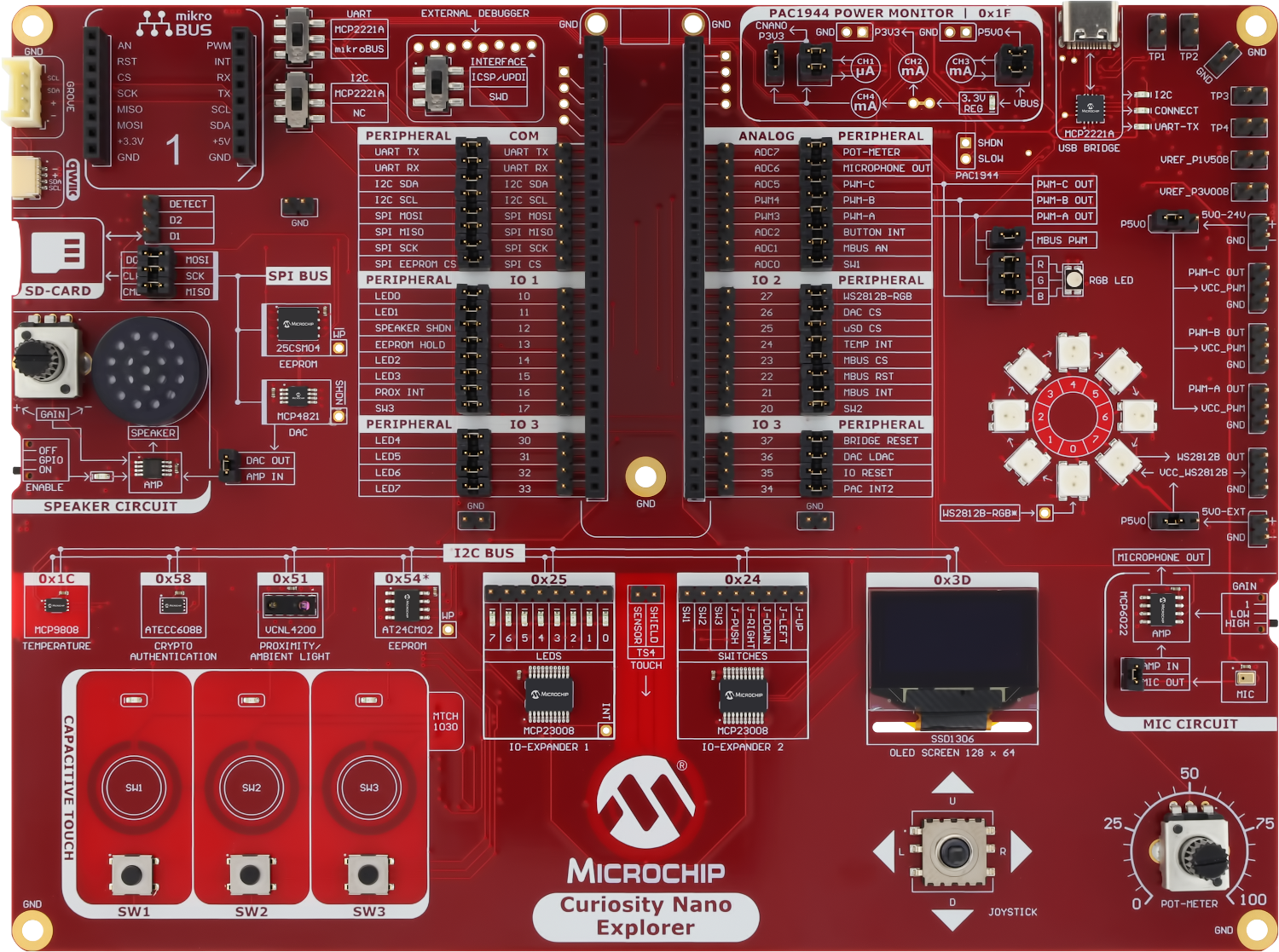2.1 Evaluation Kits
Curiosity Nano Evaluation Kits
Web Page: www.microchip.com/developmenttools/productdetails/partno/EV01G21A (scroll down on the landing page to access all the information on the kit)
Get the Kit: www.microchipdirect.com/dev-tools/EV01G21A
For more details, refer to the PIC18F56Q71 Curiosity Nano User Guide.
Features:
- Microcontroller
- One Yellow User LED
- One Mechanical User Switch
- On-Board Debugger:
- Board identification in MPLAB X Integrated Development Environment (IDE)
- One green power and status LED
- Programming and debugging
- Virtual COM port (CDC) for microcontroller to PC communication
- Data Gateway Interface (DGI): one GPIO
- USB Powered
- User Configurable VDD
- All pins are available for use
Curiosity Nano Base for Click Boards™ Evaluation Kit
The Curiosity Nano Base for Click Boards evaluation kit is a hardware extension platform intended to ease the connection between the Curiosity Nano evaluation kit, the mikroBUS™ Click boards, and the Xplained Pro extension kits.
Web Page: www.microchip.com/DevelopmentTools/ProductDetails/PartNO/AC164162
Get the Kit: www.microchipdirect.com/dev-tools/AC164162
For more details, refer to the Curiosity Nano Base for Click Boards® User Guide.
Features:
- Curiosity Nano Footprint
- One Power LED
- Three mikroBUS Sockets
- One Xplained Pro Extension Header
- Power:
- USB powered from the Curiosity Nano kit
- Alternative external power input
- Option to power from, and charge, 4.20V Li-Ion/LiPo batteries
- Fixed 3.3V PSU for target and mikroBUS sockets
- Fixed 5.0V boost converter for 5V mikroBUS sockets
Microchip Curiosity High Pin Count Development Evaluation Kit
The Microchip Curiosity High Pin Count (HPC) Development kit supports Microchip’s 28-pin and 40-pin 8-bit PIC MCUs. The expansion headers on either side of the microcontroller socket provide access to all pins on the PIC microcontroller.
Web Page: www.microchip.com/DevelopmentTools/ProductDetails/PartNO/DM164136
Get the Kit: www.microchipdirect.com/dev-tools/DM164136
For more details, refer to the Curiosity High Pin count Kit User Guide.
Features:
- MPLAB X Integrated Development Environment (IDE) compatibility
- Programming and debugging support
- Powered from USB, with option jumper for 3.3/5V
- Master Clear (MCLR) Reset
- Dual-row expansion headers
- PIC MCU PDIP sockets for 28-pin and 40-pin microcontrollers
- Two mikroBUS sockets
- Four indication LEDs
- Two push buttons
- One potentiometer
- All pins are available for use
Microchip Curiosity Low Pin Count Development Evaluation Kit
The Microchip Curiosity Low Pin Count (LPC) Development kit supports Microchip’s 8-pin, 14-pin, and 20-pin 8-bit PIC MCUs. The expansion headers on either side of the microcontroller socket provide access to all pins on the PIC microcontroller.
Web Page: www.microchip.com/DevelopmentTools/ProductDetails/PartNO/DM164137
Get the Kit: www.microchipdirect.com/dev-tools/DM164137
For more details, refer to the Curiosity Low Pin Count Development Board User Guide.
Features
- The LPC board has the same features as the HPC board aside from the differences below
- PIC MCU PDIP one socket for 8, 14-pin and 20-pin microcontrollers
- RN4020 Bluetooth Module Footprint
Microchip Curiosity Explorer Evaluation Kit
The Microchip Curiosity Nano Explorer lives up to its name by providing extensive on-board features that allow users to explore and experiment with the microcontroller peripherals of their Curiosity Nano development board. It also serves as an ideal platform to become familiar with Microchip’s software offerings, including MPLAB Code Configurator Melody.

Web Page: www.microchip.com/DevelopmentTools/ProductDetails/PartNO/EV58G97A
Get the Kit: www.microchipdirect.com/dev-tools/EV58G97A
For more details, refer to the Curiosity Nano Explorer User Guide.
Curiosity Explorer Evaluation Kit Features
|
|
